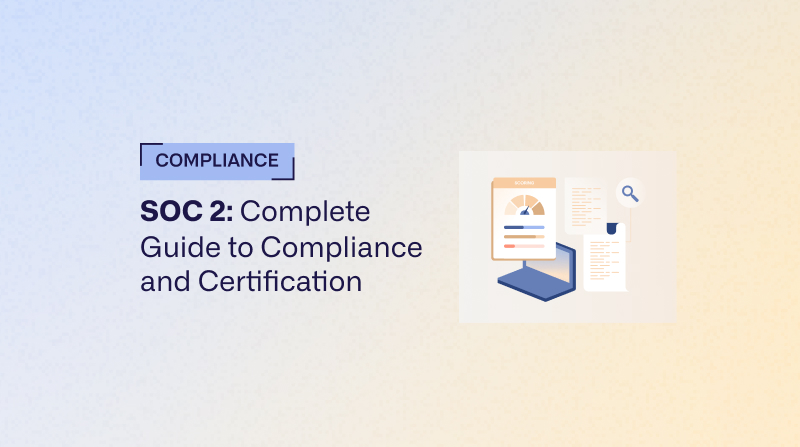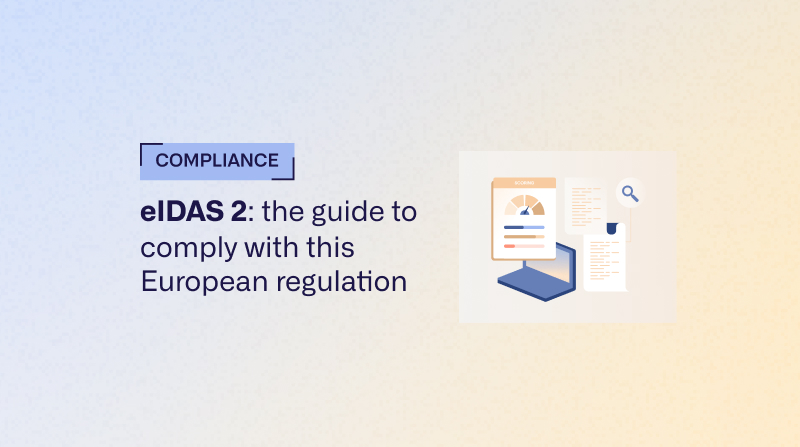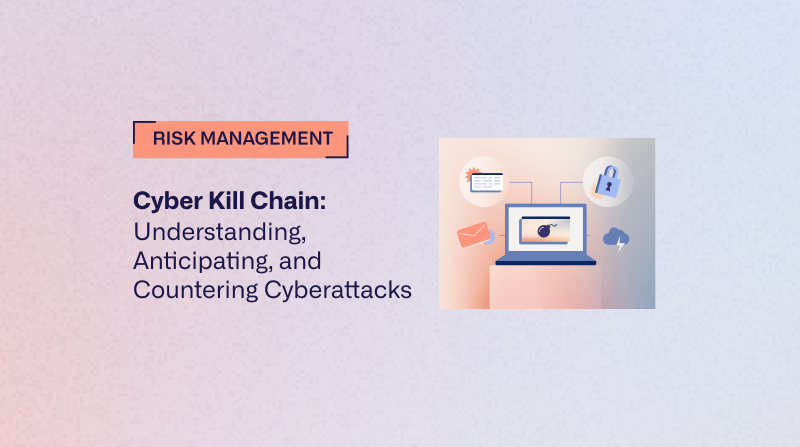SOC 2: Complete Guide to Compliance and Certification
SOC 2 compliance (Service Organization Control 2) is establishing itself as the reference in security certification for SaaS and cloud businesses. This comprehensive guide explains what SOC 2 is, how to get this certification, and why it has become a must for your business.
What is SOC 2 compliance?
SOC 2 compliance has become an unavoidable standard for companies in the technology sector, guaranteeing the security, confidentiality and availability of customer data. For an organization, obtaining this certification is not just a guarantee of trust, it is a pillar of its cyber governance and a major competitive advantage.
For a CIO, a Risk Manager or an entrepreneur, understanding the SOC 2 standard is essential to manage information protection and meet customer requirements. Much more than a simple technical audit, the SOC 2 approach requires a redesign of internal processes and a safety culture at all levels of the company.
Origins and principles of SOC 2
SOCK 2 (Service Organization Control 2) is an audit framework developed by theAmerican Institute of Certified Public Accountants (AICPA). Its objective? Evaluate how a service organization manages and protects customer data. Contrary to other standards like ISO 27001, SOC 2 does not prescribe a list of rigid checks, but is based on principles of trust, the Trust Services Criteria (TSC).
This flexibility allows each company to define its own security controls, as long as they meet the criteria relevant to the services they provide. The result of this audit is a SOC 2 report, a valuable document that attests to the maturity of the organization in terms of security Of data.
Why is SOC 2 critical for your business?
In the era of Cloud and SaaS services, customers entrust massive volumes of sensitive data to their suppliers. They need assurance that this information is managed securely and responsibly. SOC 2 certification provides this assurance.
- It reinforces customer trust : a SOC 2 report shows that you take security seriously and that your systems are reliable.
- It's a competitive advantage many businesses, especially in the United States, that require the SOC 2 compliance from their suppliers.
- It improves the governance internally : The audit preparation process requires the company to document its processes, to clarify responsibilities and to put in place robust internal controls.
The 5 principles of trust (Trust Services Criteria) SOC 2 certification
The SOC 2 framework is structured around five fundamental principles. Security is the only mandatory criterion for any SOC 2 audit. The other four are optional and selected based on the services provided by the organization.
- Safety: this is the fundamental principle of protecting information systems against unauthorized access, damage and modifications that could compromise the availability, integrity, confidentiality and privacy of data. This principle covers firewalls, intrusion detection and access management.
- Availability: this criterion relates to the accessibility of systems, products or services, in accordance with commitments made with customers. It covers performance monitoring, disaster recovery, and capacity management. The establishment of a business continuity plan is central here.
- Integrity of treatment : this principle checks whether the data processing is complete, valid, valid, accurate, timely and authorized. It ensures that the systems do their job properly, without errors or manipulations.
- Confidentiality : this criterion applies to data that is designated as confidential. It ensures that this information is protected in accordance with the commitments made. Controls include encryption and strict access control.
- Protection of privacy : This principle focuses on the collection, use, retention, disclosure, and destruction of personal information. Additionally, it is closely linked to the GDPR and other privacy regulations and aligns with concepts like the Privacy by Design.
Understand the different types of SOC reports
One of the most important aspects of the SOC 2 standard is the distinction between Type I and Type II reports. Understanding this difference is critical to setting your goals and communicating properly with your customers.
SOC 2 type 1 report: a photograph at a given moment
One SOC 2 type I report describes an organization's systems and assesses whether the design of its security controls is appropriate to achieve the relevant trust principles by a specific date.
- Objective : attest to the design of the controls at a given moment.
- Process : The auditor reviews documentation (policies, procedures) and verifies that the controls described are well designed to meet TSC criteria.
- Usage : it is often a first step towards compliance. The SOC 2 type 1 report is generally useful for new businesses that need to quickly demonstrate a commitment to security, but it offers a lower level of assurance than type 2.
SOC 2 type 2 certification report: an evaluation over time
A SOC 2 type II report goes further. It includes everything in a Type 1 report, but it also tests theoperational efficiency of these checks over a given period of time, generally 6 to 12 months.
- Objective : attest to the design AND the effectiveness of controls over a period of time.
- Process : the auditor does more than just review the documentation. It carries out tests to verify that controls worked as intended throughout the audit period (for example, by checking logs, interviewing employees, inspecting configurations).
- Usage : it is the reference standard that provides the highest level of assurance to your customers and partners, proving that your security is not only theoretical but applied on a daily basis.
SOC 1 vs SOC 2 vs SOC 3 certification: what is the difference?
- SOC 1 : focuses on internal controls related to financial reporting (ICFR). It is relevant for businesses whose services have an impact on the financial reports of their customers (for example, a payroll service provider).
- SOC 2 : as we have seen, it focuses on security, the availability, theintegrity, the confidentiality and respect for the privacy, based on TSCs. It's the ratio of choice for tech, SaaS, and cloud businesses.
- SOC 3 : a public and less detailed version of the SOC 2 report that does not contain a detailed description of the auditor's tests and results. It is designed to be freely shared on a website, like a certification seal, and attests that the organization has obtained a SOC 2 report without disclosing sensitive information.
An SOC 2 compliance process cannot be improvised. It requires mapping risks, documenting controls, and tracking their effectiveness.
With a platform of Cyber Security GRC suchlike Egerie, you can centralize your control repository, align it with SOC 2 criteria and automate the monitoring of your compliance.
To find out how, ask for a demo of our platform tool.
How to get SOC 2 certification: 5 key steps
Obtaining a SOC 2 certification is a major project that involves the entire company, in particular your information systems department (DSI). The process can take 6 to 18 months and requires careful preparation. Here are the main steps to make your project a success.
1. Define the scope of the audit
It is the first and probably the most critical step.. You need to decide what systems, services, processes, and trust principles will be included in the audit.
- Choosing the Trust Services Criteria : beyond security, a mandatory criterion, determine whether you should include availability, integrity, confidentiality and/or privacy. This choice depends on the services you sell and the promises you make to your customers. For example, a cloud storage business will certainly need to include availability and privacy.
- Identify perimeter systems : List all the applications, databases, infrastructures, and third party services that contribute to the delivery of your service. Each component on this list should be covered by checks.
2. Conduct a gap analysis
Once the scope is defined, the next step is to compare your existing controls to the requirements of criteria TSC Chose. This is called gap analysis.
- Map existing controls : document everything you already do with security: policies, procedures, technical configurations, etc.
- Identify gaps : For each TSC requirement, determine if you have a control in place. If this is not the case, or if the control is weak, you have identified a “gap”. For example, if TSC requires a quarterly access review process and you don't, that's a gap that needs to be filled.
- Prioritize actions : a gap analysis can reveal dozens or even hundreds of points that need to be corrected. It is crucial to prioritize them according to the risk and the effort required. One risk analysis Formal is essential at this stage.
3. Implement remediations
This phase consists of closing the identified gaps. This is where the CIO and his teams are most in demand. Actions can be very varied in nature:
- Documentation : write or update security policies, incident management procedures, a business resumption plan, etc.
- Technique: Set up a Computer bastion, set up a centralized logging system, strengthen password policies, deploy encryption such as the IPsec protocol, etc.
- Organizational : set up formal processes for welcoming new employees (onboarding), managing changes, reviewing access or even management of risks associated with third parties.
4. Choosing an auditor and preparing for the audit
The choice of the auditor, namely an accounting firm approved by the AICPA, is an important decision. Look for a partner who has experience in your industry.
Once the auditor is chosen, the audit preparation phase begins. The auditor will review your preparatory work, ask you questions and give you initial feedback on your level of preparation. It is a kind of “pre-audit” that allows you to correct the last details before the formal audit.
5. Pass the SOC 2 audit
It is the moment of truth. The auditor will collect evidence (log sampling, screenshots, interviews) to test the design (Type 1) and effectiveness (Type 2) of your controls over the defined period.
The role of Information Systems Security Manager (RSSI) is central here. He must coordinate the collection of evidence, answer questions from the auditor, and ensure that all teams collaborate.
At the end of the audit, the auditor produces the SOC 2 report. This report contains his opinion, a description of your systems, and details of the checks and tests performed. SOC 2 compliance is not a one-time project; the report must be renewed every year.
Do you need a trusted partner to insure your cyber GRC?
The success of a SOC 2 audit is based on a Regulatory watch continuous and proactive management of controls.
A platform like Egerie allows you to maintain this compliance posture on an ongoing basis, by alerting to discrepancies and by providing dashboards to manage your safety.
Want to know more? Schedule your demo now with our team of cyber GRC experts.
SOC 2 compliance FAQ
This section answers frequently asked questions about the SOC 2 standard, its cost, duration, and comparison with other security standards.
What is the difference between SOC 2 and ISO 27001?
SOC 2 and ISO 27001 are two of the most respected security frameworks, but they have different philosophies and applications.
- Perimeter : the ISO 27001 standard certifies an information security management system (ISMS) for the entire organization. SOC 2 focuses on controls related to the services provided to customers.
- Approach : ISO 27001 is prescriptive, with a list of 114 controls in its Annex A. SOC 2 is based on principles (TSCs), offering more flexibility in the choice of controls.
- Deliverable : ISO 27001 issues a certificate of conformity (valid for 3 years with annual surveillance audits). SOC 2 produces a detailed audit report (to be renewed every year).
- Recognition : ISO 27001 is an international standard that is recognized all over the world. SOC 2 is mainly recognized in North America, although its adoption in Europe is growing strongly, especially in the SaaS ecosystem.
Who needs SOC 2 certification?
The SOC 2 certification is mainly aimed at:
- SaaS publishers and cloud providers
- Tech companies dealing with sensitive customer data
- IT service providers
- Startups looking to conquer the North American market
How much does a SOC 2 audit cost?
The cost of a SOC 2 audit varies considerably depending on several factors : the size of the company, the complexity of its systems, the scope of the audit (number of TSCs) and the audit firm chosen.
It is necessary to distinguish two types of costs:
- Preparation costs which include the internal time of the teams, the possible purchase of a cybersecurity software or compliance tools, and the services of consultants for gap analysis. These costs can be significant.
- Audit costs which can amount to €15,000, up to more than €100,000 per year, depending on the factors mentioned above. A Type 2 report is generally more expensive than a Type 1 because of the additional test work.
How long does it take to get SOC 2 certification?
The duration of the project depends on the initial maturity level of the company.
- For a type 1 report, if your controls are already in place, the process may take 3 to 6 months.
- For a type 2 report, add the observation period, at least 3 months, generally ranging from 6 to 12 months. A complete project, from defining the scope to obtaining a SOC 2 type 2 report, often lasts between 12 and 18 months for a first certification.
Can a company be “SOC 2 certified”?
Technically, a company is not “certified” SOC 2. She receives a certificate or an audit report from an independent firm. Unlike ISO 27001, which issues a formal certificate, SOC 2 results in a report with an auditor opinion. However, in everyday language, the terms “SOC 2 certification” or “SOC 2 compliance” are widely used to indicate that a company has successfully passed a SOC 2 audit.
Managing a SOC 2 compliance project is a complex task that requires perfect visibility into your assets, risks and controls. A cybersecurity management platform like Egerie transforms this challenge into a structured and controlled process.
By centralizing your governance, you not only accelerate your SOC 2 audit, but you also sustainably strengthen the security posture of your company facing cybersecurity. To see how our solution can help you, request a personalized demonstration.








